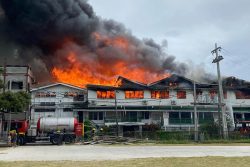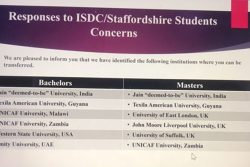 In what was a particularly interesting development on the Guyanese stage, the Georgetown International Academy (GIA) performed Almost, Maine, a play by American actor/playwright John Cariani, directed by Subraj Singh at the Theatre Guild Playhouse last week.
In what was a particularly interesting development on the Guyanese stage, the Georgetown International Academy (GIA) performed Almost, Maine, a play by American actor/playwright John Cariani, directed by Subraj Singh at the Theatre Guild Playhouse last week.
There were several significant factors. These include the appearance of an American romantic comedy on stage in Guyana; the achievements of and the commendations due to the GIA, to Singh and his students who worked in the production; this public performance by a secondary school in the context of drama in Guyanese schools; the rarity of such productions – but the recent upsurge in community theatre by schools; and the important stimuli for this theatre, which include the CXC drama exams, the outreach of the National School of Theatre Arts and Drama (NSTAD) and the National Drama Festival (NDF).
Almost, Maine was a rare public performance of full-length drama by a secondary school in Guyana. These are very scarce. They used to be in fashion a long time ago but are now virtually extinct. Interestingly, only private schools have done them recently. Some years ago, School of the Nations had productions with a preference for classics, if not for musicals, such as The Mikado, but those have ceased. Today, only the GIA persists with its an annual production of American musicals.
But there have been promising signs. Between March and April this year, a few public secondary schools performed in their communities: Berbice Education Institute directed by Antacia Thomas, Tutorial Academy directed by Mehalai McAlmont, and St Joseph High directed by Lloyd Thomas, all did it for the second consecutive year. This year, West Demerara Secondary led by Tanika Caldeira, Berbice High led by Shinellie Kendall, Port Mourant Secondary led by Rayel Franklin, and the Bishops’ High joined the list.
The GIA, however, leads the way, obviously with theatre on its agenda. The fact that National Drama Company (NDC) member and award-winning playwright and fiction writer Singh is now on staff there could only have given the school an effective boost. This private secondary, popularly known in Guyana as ‘the American School’, continued its annual musicals with Beauty and the Beast in April, and to follow it up with Almost, Maine less than two months after that is surprising and highly commendable.
This was a much slimmer production, far less elaborate and with a more manageable cast than Beauty and the Beast. It was performed by Magic and Monsters Performing Arts Club, made up of students in the school. But it was still a large number of them given that Almost, Maine comprises a series of short dramas and Singh used a different cast for each. The cast amounted to more than 20 actors and actresses. None of them was called upon to do more than one fairly short piece, so their workload was minimised.
Almost, Maine was set in winter in Maine, USA, in a fictitious town named Almost. Quite likely that is a symbolic title since the play as a whole captures a considerable range of dramatic situations and emotions shared by people who can almost represent citizens of Maine. Their environment could almost be Maine although each situation and set of relationships were meant to be universal – people everywhere rather than specifically belonging to that one American state. However, the dramatic pieces all had a distinct small-town feel with characters locked into a fairly confined geographical space.
The season may also be symbolically significant. It is freezing, forcing everyone to seek warmth – in a few instances characters have to peel off a laughable burden of multiple layers of clothing. There is a persistent want of comfort, of human companionship, of warmth against a hostile (cold, freezing) environment. It is a romantic comedy so what the couples always seek is romantic love. Every piece was a story of a couple with a theme of love or getting together with the opposite sex (not quite the opposite in all cases, though).
While the emotions were very well played, this vital element of winter and its emotional meaning to the play did not quite materialise. There was snow on the ground – a good visual effect, and sometimes specific reference to the winter, but the audience never felt it. The production did not play on the fact that it was cold outside, that the characters were often one step away from freezing.
This play with its several self-contained plots is Simonian. It is highly reminiscent of Neil Simon, the foremost American dramatist with his successful romantic comedies. Of particular interest here is The Good Doctor – a compilation of short scenes independent of each other. The link is the doctor who is a sort of choric presenter of different scenes involving people and emotions, often with humour. Simon’s is a more profound drama than Cariani’s.
One outstanding feature of Singh’s production of Cariani’s play, however, is the success of the acting. It was performed on a minimalist set; quite sparse as demanded by the many different scenes and the frequent changes. The snow on the ground persisted without being transferred to the acting, but everything helped to isolate the acting and more definitely demonstrate acting as the most successful element in the play.
These were very youthful performers playing sometimes very adult roles. They sometimes did not capture the full depth of nuances, feeling and character because of inexperience, but always the acting was sincere, and it worked in all the scenes. It is not easy to single out by name all the more memorable or most effective performances because performers were not identified in the programme. They were listed as “Samara O. and Eros J.”, or “Darren H.” and “Alexei H.” It was not clear what the strategy was or why the actors and actresses needed to be protected or not be identified with the roles they played. Was it because it was an adult play?
Despite that, there were some excellent performances that can be named. Some of them may be pinpointed. One that was exceptional was Rachel Mekdeci who had no problem being her character. She was credible and convincing, and her role and situation could be seen, as she understood the subtleties with good pace and timing.
Mekdeci appeared in “Sad and Glad” and played a girl who had a chance meeting with her former lover after a long separation. She had the challenging role of having to resist his renewed advances and let him down gently when she had to break the news that she was just about to get married. These she handled with mature sensitivity and credibility. Mekdeci performed along with Ariefa R. and Jessy B, who both lent adequate support and were also superior in their roles. Playing opposite Mekdeci, Ariefa added completeness and comprehension to the scene. Alexander S. stood out among the males in “Where It Went”. This playlet depended on certain ironies and subtleties, requiring sensitive performance which he provided effectively.
In “They Fell”, Sakinah K. reports to her best friend (Naomi H.) the failure of her friendship with a boy and ends up confessing that she was actually in love with the girl who is her friend. It turns out in the end, that the girl is also in love with her. Given the Guyanese audience’s usual discomfort with lesbianism or gay couples, this drama was received very well. Among the reasons must have been the humour with which “they fell” in love and the effective acting of the two, especially Sakinah K., who happened to be Sakinah Khan.
Each piece was tightly directed and the cast very disciplined. Despite set changes, the play proceeded with good pace. It entertained and showed that its type – the romantic comedy – has a place on stage in Guyana.
While the GIA has established its record as a private school with drama on the agenda, other public schools might well be getting there. An increasing number of schools are taking CXC drama at both the Caribbean Secondary Education Certificate and the Caribbean Advanced Proficiency Examination levels. That has been a driving factor in the generation of public productions. Added to that it is a part of the outreach scheme of the training and propagation of drama provided by the NSTAD, whose annual summer workshops (in collaboration with the NDC) have been attended by some of the teachers.
Other teachers who have done plays publicly are graduates of NSTAD. Yet others have been stimulated by the NDF managed by NSTAD where community theatre in various corners of Guyana is one of the targets.
The GIA, however, is not part of any of those programmes, but has been setting the example for years. In the end, it matters less whose lead is followed and more that secondary schools get (back) in the business of producing plays for a public audience.









